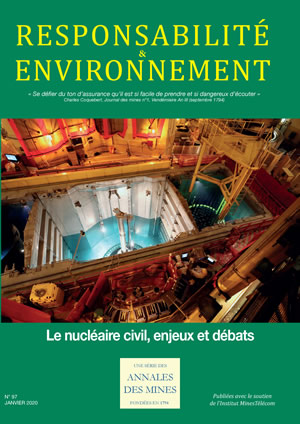|
 N° 97 - Janvier 2020 - Le nucléaire civil, enjeux et débats N° 97 - Janvier 2020 - Le nucléaire civil, enjeux et débats
Nuclear Power in a Clean Energy System
By Keisuke SADAMORI
International Energy Agency (IEA)
Nuclear power, along with hydropower, forms the backbone of low carbon electricity generation today; together they provide three-quarters of global low-carbon generation today. Over the past 50 years, nuclear power has reduced CO2 emissions by over 60 gigatonnes – nearly two years’ worth of global energy-related emissions. Yet in the advanced economies, nuclear power has begun to fade, with plants closing and little new investment, just when the world requires more low-carbon electricity. This paper focuses on the role of nuclear power in the advanced economies today and the factors that put nuclear power there at risk of decline tomorrow. The paper shows that without action nuclear power in the advanced economies could fall by two-thirds to 2040. It examines the implications of such a decline for emissions and for electricity security.
Achieving the pace of CO2 emission reductions in line with the Paris Agreement is already a huge challenge, requiring large increases in efficiency and renewables investments, as well as an increase in nuclear power. This paper identifies the even-greater challenges of attempting to follow this path with much less nuclear power, including an additional USD 1.6 trillion in investment needs and 5% higher cost to consumers in advanced economies. This paper recommends several actions to governments open to nuclear power that aim to ensure existing plants can operate as long as they are safe, support new nuclear construction, and encourage new nuclear technologies to be developed.
 Télécharger gratuitement l'article Télécharger gratuitement l'article
 Retour au sommaire Retour au sommaire
 N° 97 - January 2020 -Civilian nuclear power: Issues and debates N° 97 - January 2020 -Civilian nuclear power: Issues and debates
Nuclear Power in a Clean Energy System
Keisuke Sadamori,
International Energy Agency (IEA)
Nuclear power, along with hydropower, forms the backbone of low carbon electricity generation today; together they provide three-quarters of global low-carbon generation today. Over the past 50 years, nuclear power has reduced CO2 emissions by over 60 gigatonnes – nearly two years’ worth of global energy-related emissions. Yet in the advanced economies, nuclear power has begun to fade, with plants closing and little new investment, just when the world requires more low-carbon electricity. This paper focuses on the role of nuclear power in the advanced economies today and the factors that put nuclear power there at risk of decline tomorrow. The paper shows that without action nuclear power in the advanced economies could fall by two-thirds to 2040. It examines the implications of such a decline for emissions and for electricity security.
Achieving the pace of CO2 emission reductions in line with the Paris Agreement is already a huge challenge, requiring large increases in efficiency and renewables investments, as well as an increase in nuclear power. This paper identifies the even-greater challenges of attempting to follow this path with much less nuclear power, including an additional USD 1.6 trillion in investment needs and 5% higher cost to consumers in advanced economies. This paper recommends several actions to governments open to nuclear power that aim to ensure existing plants can operate as long as they are safe, support new nuclear construction, and encourage new nuclear technologies to be developed.
 Retour au sommaire Retour au sommaire
|




